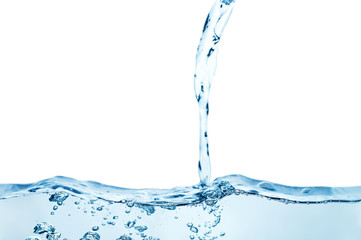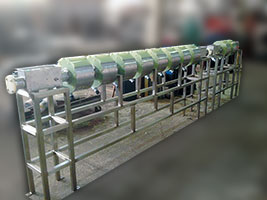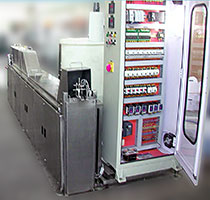WHAT IS W3 DEVELOPMENT LLC?
W3 DEVELOPMENT LLC performs the Research and Development of the physical apparatus (equipment and systems), in cooperation with WAT&R Center or other R&D sources, necessary in the development of new and improved water, or other liquid, based PROCESSES. In particular, the apparatus based on recently filed sonic patent technologies allows, and actually requires, new processes to be developed. These processes can integrate existing processing technologies to produce highly effective hybrid processes for the specific applications.
Once a process is established, W3 Development then develops the automation, control and ancillary equipment necessary to operate the system at optimum performance in everyday use. The Guiding Criteria for apparatus development are:
- SIMPLICITY OF CONSTRUCTION AND SERVICE
- COST EFFECTIVE UTILIZATION
- LINEAR SCALEABLITY
- STATE OF THE ART OPERATION and CONTROL
- SUPPLY CHAIN OPTIMIZATION
Some of the apparatus recently developed by W3 Development are individual equipments that are basic to all Water Recovery processes. Current Application Projects WAT&R are spun off of these base units. In addition to WAT&R related equipment, W3 Development also develops equipment to other ultrasonic applications. A predominant concept behind much the company’s development comes off of their “surround” concept.
EVOLUTION OF THE “SURROUND” CONCEPT TO WATER PRODUCTION AND RECOVERY
“Surround” is the term to describe a whole new approach of using electro-mechanical high power acoustic sound waves as the primary energy force WHILE FLOWING THE LIQUID OR PARTS THROUGH THE SOUND WAVES. Virtually all applications of water processing or parts cleaning have relied on either A) a static, or near static, process for chemical or ultrasonics; or B) a turbulent bath for aeration or filtration. Previously, the mechanical power of sound waves is nullified if movement of the solution or parts in the solution is too great.
We developed the “surround” concept many years ago by directing UNIDIRECTIONAL ultrasonic sound waves into a round vessel. An ultrasonic transducer’s maximum cavitation action occurs in the solution immediately in front of the transducer's radiating surface. We refer to that as PRIMARY CAVITATION energy. The more powerful the sound waves the more cavitation energy released. Continued innovation led to designs that create OMNIDIRECTIONAL waves resulting in what we refer to as SECONDARY CAVITATION energy.
Originally developed to produce a more effective sonically active bath solution by designing the highest power ultrasonics to produce the HIGHEST PRIMARY AND SECONDARY CAVITATION ENERGY, we continued to innovate development, using our over 40 years of design and manufacture of transducers, power supplies and vessels using high power acoustics. In the course of our innovating, we developed methods and apparatus to successfully apply powerful sonics to accomplish results on FLOWING LIQUIDS previously impossible with sonics. Further development led to the multiple recent patent filings focused on freshwater production and recovery.
topSURROUND APPLICATIONS EVOLUTION
 |
||
40 years of experience Developing Acoustic Technology For Continuous Flow Processing of WIRE & RELATED PRODUCTS |
Decades of experience Developing Acoustic Technology For Continuous Flow Processing of DISCREET PARTS & ASSEMBLIES |
And now breakthrough patents Developing Acoustic Technology For Continuous Flow Processing of WATER & OTHER LIQUIDS |
Surround products started with W3 cylindrical transducers shown here. Initially this style transducer was used to clean wire products in line at high speed. The systems were later expanded to strip, rod, conduit and other in- line product applications, then into a broader line of Surround transducers to enable conveyorized systems.
The Surround product family now includes submersible transducers, many larger sizes, a myriad of tank configurations and most recently led to development of the SOLIDS DISOCCIATION APPARATUS (SDA) and SOLIDS SEPARATION APPARATUS (SSA) which are based on the core principles of the WATER RECOVERY AND PRODUCTION technologies. contact W3
top
WATER RECOVERY AND PROCESSING APPARATUS UNDER DEVELOPMENT
SOLIDS DISASSOCIATION APPARATUS (SDA)
The SDA is designed specifically to apply intense sonic waves to FLOWING LIQUIDS via microscopic bursts of energy which result in high heat and pressure power to those liquids. This energy imparted on the liquid solutions can both emulsify or breakdown the components in the liquid depending on how the sonics are applied. The power is sufficient to breakdown (disassociate) chemical compounds and eviscerate microorganisms and algae. The solution now contains vast particles of suspended and dissolved solids available for separation from the liquid, usually water.
W3 Development, through access to the new technologies has developed this SDA apparatus in several versions available for process development work directly and through WAT&R.
The SDA schedule effective at the start of 2024:
- 4Q23 - Test Mule for process development
- 1Q24 – Gen 1 commercial design completion
- 1Q24 - Final production development testing
- 2Q24 – Gen 1 commercial production
- 4Q24 – Gen 2 development
Any application where breakdown of the solution components is important to the process, the SDA is the equipment technology to use. contact W3
topSOLIDS SEPARATION APPARATUS (SSA)
The SSA is designed specifically to apply intense sonic waves to flowing liquids for the purpose of extracting Total Dissolved Solids (TDS) from the liquid as it flows. Here the sonic waves are applied differently than the SDA resulting in two exit streams separated by the SSA. One is a permeate stream of water and the other is an effluent stream of concentrated waste, often referred to as brine. Dissolved solids contained in the source stream, such as seawater, industrial and biological processes or from the SDA directly can be processed through the SSA.
W3 Development, through access to the new technologies has developed this SSA apparatus in several versions available for process development work directly and through WAT&R.
The SSA schedule effective at the start of 2024:
- 1Q24 - Final Test Mule for process development
- 2Q24 – Gen 1 commercial design completion
- 2Q24 - Final production development testing
- 3Q24 – Gen 1 commercial production
- 1Q25 – Gen 2 development
Any application where separation of Total Dissolved Solids (TDS) from the parent liquid, usually water, is important to the process, the SSA is the equipment technology to use. contact W3
topCELLULAR FLUID PROCESSING MODULE (CFPM-M1)
The CFPM-M1 is the initial commercial production model that is targeted for commercial release. The project phases concurrently underway toward completion:
The SDA schedule effective at the start of 2024:
- Component development
- Full system model development
- Component and full system testing
- Full operational vetting
- Initial sales/installation/service/ marketing channels
- Domestic and international partners
The CFPM-M1 target features are:
- Commercially viable, proprietary design using patented technology
- Fully automated and self-contained electro-mechanical operation
- Stand alone with no process stage moving components
- Process water at nominal flow rate of 16.7 gpm (1000 gph), 63.2 l/m (3,792 l/hr)
- Destroy microorganisms and remove a nominal 99% of Total Dissolved Solids (TDS)
- Requires only electrical power input of 6 kW (from any energy source)
- Rated 20/7/360/12 operation provides for normal recommended service downtime
- Encompasses an area approximately 4' by 8' or 32 sf, (1.2m by 2.4m or 1.7m2)
- Incorporates expandable and scalable technology
- Lower total costs compared to existing methods performing the same, or similar, processes
The CFPM-M1 schedule effective at the start of 2024:
- 2Q24 - Test Mule for process development
- 3Q24 – Gen 1 commercial design completion
- 4Q24 - Final production development testing
- 2Q25 – Gen 1 commercial production
- 4Q25 – Gen 2 development
Creating freshwater from any available water source in a compact module in virtually environment with a power source is the purpose of the Cellular Fluid Processing Module (CFPM-M1).
topW3 product philosophy is based in making the product fit the application rather than making the application fit the product.
All selections of equipment are first preceded with a thorough analysis of your specific application and production needs with one of our experienced W3 Ultrasonic application personnel.
Start the Process Development analysis yourself or Contact W3 directly.

